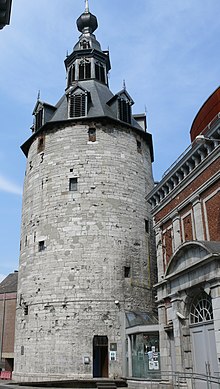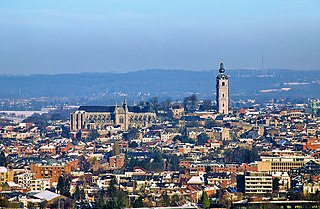
Mons is a city and municipality of Wallonia, and the capital of the province of Hainaut, Belgium.
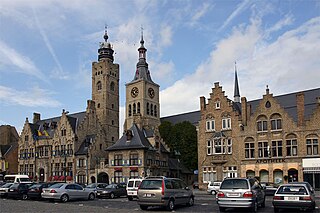
Diksmuide is a Belgian city and municipality in the Flemish province of West Flanders. The municipality comprises the city of Diksmuide proper and the former communes of Beerst, Esen, Kaaskerke, Keiem, Lampernisse, Leke, Nieuwkapelle, Oostkerke, Oudekapelle, Pervijze, Sint-Jacobs-Kapelle, Stuivekenskerke, Vladslo and Woumen.

Lo-Reninge is a city and municipality located in the Belgian province of West Flanders. The municipality comprises the towns of Lo, Noordschote, Pollinkhove and Reninge. On January 1, 2006, Lo-Reninge had a total population of 3,306. The total area is 62.94 km2 which gives a population density of 53 inhabitants per km2. The Old Town Hall of Lo, built between 1565 and 1566, and its belfry were inscribed on the UNESCO World Heritage List in 1999 as part of the Belfries of Belgium and France site.

Nieuwpoort is a city and municipality located in Flanders, one of the three regions of Belgium, in the province of West Flanders. The municipality comprises the town of Nieuwpoort proper, as well as Ramskapelle and Sint-Joris. On 1 January 2008, Nieuwpoort had a total population of 11,062. Its land area is 31.00 km² which gives a population density of 350 inhabitants per km². The current mayor of Nieuwpoort is Geert Vanden Broucke (CD&V)

Veurne is a city and municipality in the Belgian province of West Flanders. The municipality comprises the town of Veurne proper and the settlements of Avekapelle, Booitshoeke, Bulskamp, De Moeren (Belgium), Eggewaartskapelle, Houtem, Steenkerke, Vinkem, Wulveringem, and Zoutenaaie.

Herentals is a city in the province of Antwerp. The municipality comprises the city of Herentals proper and the towns of Morkhoven and Noorderwijk. In 2022, Herentals had a total population of 28.455. The total area is 48.56 km2 (18.75 sq mi). Saint Waltrude is the patron saint of the city.

Sint-Truiden is a city and municipality located in the province of Limburg, Flemish Region, Belgium, and has over 41,500 inhabitants, which makes it one of the largest cities in Limburg. The municipality includes the former communes of Aalst, Brustem, Duras, Engelmanshoven, Gelinden, Gorsem, Groot-Gelmen, Halmaal, Kerkom-bij-Sint-Truiden, Melveren, Metsteren, Ordingen, Runkelen, Velm, Wilderen, and Zepperen.
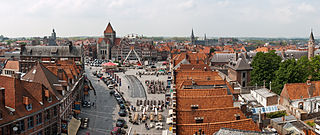
Tournai or Tournay is a city and municipality of Wallonia located in the Province of Hainaut, Belgium. It lies 89 km (55 mi) by road southwest of the centre of Brussels on the river Scheldt, and is part of Eurometropolis Lille–Kortrijk–Tournai, In 2022, the municipality of Tournai had an estimated population of 68,518 people.
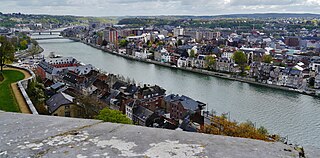
Namur is a city and municipality in Wallonia, Belgium. It is the capital both of the province of Namur and of Wallonia, hosting the Parliament of Wallonia, the Government of Wallonia and its administration.

Lier is a municipality located in the Belgian province of Antwerp. It is composed of the city of Lier proper and the village of Koningshooikt. The city centre is surrounded by the river Nete, around which it grew. In 2018, Lier had a total population of 35,712. The total area is 49.70 km2 making a population density (PD) of 720 per km2. Lier is known for its beers, its patron saint St. Gummarus and Lierse vlaaikes cake. It is also home to the world headquarters of Van Hool, a global bus and coach manufacturer. Lier's two principal football clubs are K. Lyra-Lierse and Lierse Kempenzonen.

Bergues is a commune in the Nord department in northern France.

Doullens is a commune in the Somme department, Hauts-de-France, France.

Aire-sur-la-Lys is a commune in the Pas-de-Calais department in northern France.

The Belfries of Belgium and France are a group of 56 historical buildings designated by UNESCO as World Heritage Sites, in recognition of the civic belfries serving as an architectural manifestation of emerging civic independence from feudal and religious influences in the former County of Flanders and neighbouring areas which once were possessions of the House of Burgundy.

Lucheux is a commune in the Somme department in Hauts-de-France in northern France.

Saint Peter's Church is a Roman Catholic church in Leuven, Belgium, built in the 15th century in the Brabantine Gothic style. The church has a cruciform floor plan and a low bell tower that has never been completed. It is 93 metres (305 ft) long. It is located on the city's Grote Markt, opposite the Town Hall. In 1999, the belfry and bell tower of the church was inscribed on the UNESCO World Heritage List as part of the Belfries of Belgium and France site, in recognition of the civil importance and architecture of the belfries in the region.

The Walled City of Jajce is a medieval fortified nucleus of Jajce in Bosnia and Herzegovina, with Jajce Citadel high above town on top of pyramidal-shaped steep hill, enclosed with approximately 1,300 metres (4,300 ft) long defensive walls,. It is one of the best preserved fortified capitals of the Bosnian Kingdom, the last stronghold before the kingdom dissolved under the pressure of military advancement at the onset of Ottoman Empire takeover.

The Tournaisis, or Tournai, a territory in the Low Countries in present-day Belgium, is one of Europe's oldest town centres. Located in the Wallonia region of Belgium on the Scheldt River, northwest of Mons, Tournai residents are primarily French-speaking. It is home to some of the oldest and best preserved medieval architecture in Europe, notably the Cathédrale Notre Dame and the Belfry of Tournai, a belltower built in 1188, both of which are designated UNESCO World Heritage sites. The River Scheldt's access to the sea made Tournai a trading hub in the Middle Ages.

Bruges is the capital and largest city of the province of West Flanders in the Flemish Region of Belgium, in the northwest of the country. It is the sixth most populous city in the country.
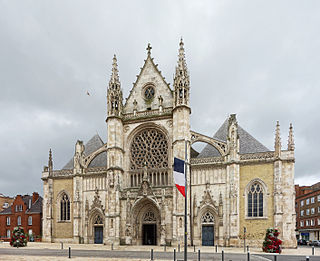
The Church of Saint-Éloi, nicknamed the Cathedral of the Sands, is a Roman Catholic church in Dunkirk, France. It was listed as a Historic Monument in 1916, whereas the belfry of the original church across the street was listed in 1840. The belfry is also part of the World Heritage-listed Belfries of Belgium and France.
